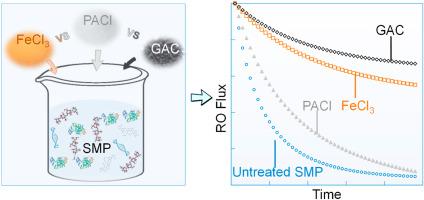Journal of Membrane Science ( IF 8.4 ) Pub Date : 2021-09-10 , DOI: 10.1016/j.memsci.2021.119850 Gen-Qiang Chen 1, 2 , Yin-Hu Wu 1, 2 , Pin-Sheng Fang 1, 2 , Yuan Bai 1, 2 , Zhuo Chen 1, 2 , Yu-Qing Xu 1, 2 , Yun-Hong Wang 1, 2 , Xing Tong 1, 2 , Li-Wei Luo 1, 2 , Hao-Bin Wang 1, 2 , Zi-Wei Zhang 1, 2 , Nozomu Ikuno 3 , Hong-Ying Hu 1, 2, 4

|
Soluble microbial products (SMP) are one of the main causes of reverse osmosis (RO) membrane fouling in wastewater reclamation, and coagulation and adsorption are commonly used to prevent such fouling. However, the mechanism by which typical coagulants and adsorbents affect the RO membrane fouling caused by SMP remains unclear. In this study, two bacterial strains isolated from fouled RO membranes in a full-scale wastewater reclamation plant were used to produce SMP. Both bacterial strains were found to generate high SMP yield (0.23–0.25 g/g), which caused severe RO membrane fouling. Coagulation by polyaluminum chloride (PACl) and ferric chloride (FeCl3) and adsorption by granular activated carbon (GAC) were applied as pretreatment methods to alleviate the membrane fouling caused by SMP. Compared with PACl, FeCl3 performed better in removing SMP, decreasing fluorescence intensity, and reducing molecular weight (MW). GAC preferentially adsorbed protein and humic substances in SMP and unselectively and efficiently removed fluorescent compounds; however, it could only remove a limited amount of the high-MW compound. The RO membrane fouling potential of treated SMP was investigated, and FeCl3 and GAC were found to effectively alleviate the fouling. In addition to a decrease in the dissolved organic carbon content of SMP, a decrease in specific fluorescence intensity, MW, and polysaccharide content caused by coagulation or adsorption could result in lower RO membrane fouling.
中文翻译:

不同预处理方法缓解可溶性微生物产物引起的反渗透膜污染的性能
可溶性微生物产物(SMP)是废水回收中反渗透(RO)膜污染的主要原因之一,通常采用混凝和吸附来防止这种污染。然而,典型的混凝剂和吸附剂影响 SMP 引起的 RO 膜污染的机制尚不清楚。在本研究中,使用从大型废水回收厂污染的 RO 膜中分离出的两种细菌菌株来生产 SMP。发现两种细菌菌株都能产生高 SMP 产量 (0.23–0.25 g/g),这会导致严重的 RO 膜污染。聚合氯化铝 (PACl) 和氯化铁 (FeCl 3 ) 混凝) 和颗粒活性炭 (GAC) 吸附被用作预处理方法,以减轻 SMP 引起的膜污染。与PACl相比,FeCl 3在去除SMP、降低荧光强度和降低分子量(MW)方面表现更好。GAC优先吸附SMP中的蛋白质和腐殖质,非选择性有效去除荧光化合物;然而,它只能去除有限量的高分子量化合物。研究了处理过的 SMP 的 RO 膜污染潜力,FeCl 3发现 GAC 和 GAC 可有效减轻结垢。除了 SMP 的溶解有机碳含量降低之外,由于凝结或吸附导致的特定荧光强度、MW 和多糖含量的降低也可能导致 RO 膜污染降低。











































 京公网安备 11010802027423号
京公网安备 11010802027423号